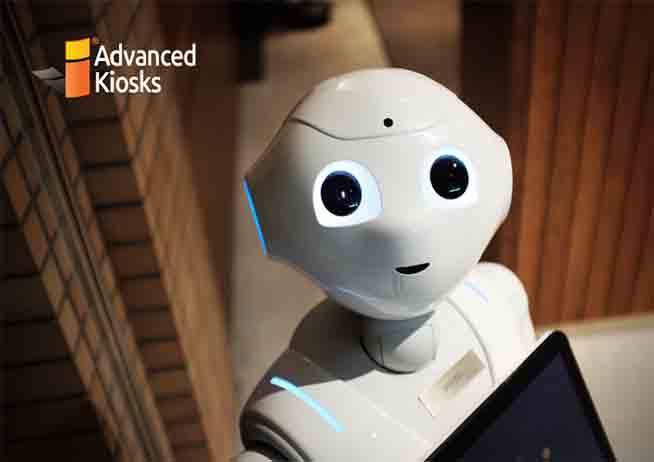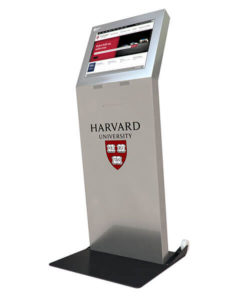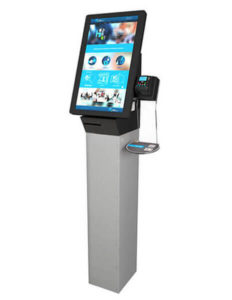As a sci-fi nerd, I spend a lot of time imagining what commonplace items like a touch screen kiosk will be like in the future.
- Will they follow the trend of all things tech getting smaller and sleeker?
- Will their displays be able to leap off the screen and project in front of us like we see in so many movies?
- Will they become self-aware, go full Skynet and try to take over humanity?
Well, probably not that last one (unless you ask Elon Musk, of course) but you get the idea. When considering the trajectory of the future, I’m of the mind that it’s helpful to look back on the past.
ATMS: Our first touch screen kiosk experience
While the technology that powers touch screens can trace itself all the way back to the 1940’s, for most of us, our first introduction to touch screen kiosk technology came in the form of the automated teller machines, or ATMs, that began to hit the market in the early 1970s. Big and boxy, these metallic behemoths represented a revolutionary development for their time. Designed to give consumers easy access to cash while also allowing bank employees to focus on bigger picture financial tasks, the ATM was all about personal empowerment.
As far as the screens themselves are concerned, the first ATMs employed what’s known as resistive touchscreen technology. This was done by placing a conductive covering over the screen that would make contact with a second conductive sheet that contained the tracer dots. When someone used their hand to apply pressure to the screen, the circuit between the two conductive covers would be closed and the trace dots would register one singular touch point that could be used to interact with the screen.
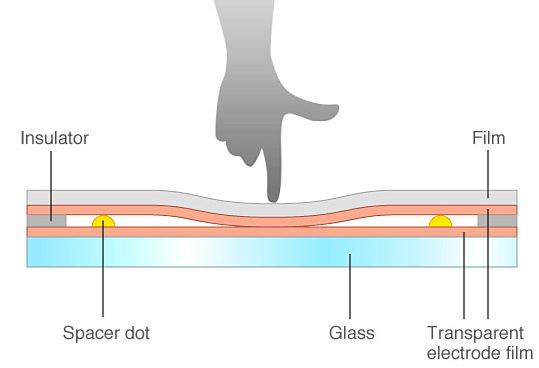
By pressing down on the surface of a resistive touchscreen, the two layers of transparent electrode film will come into contact with the tracer dots and register a singular touch point.
The fact that only pressure was needed meant that the screens could be used if they were dirty or smudged, or if the user was wearing gloves. While the rudimentary technology limited image clarity and prevented any sort of swiping, the low cost and durability made the design perfect for ATMS, early arcade games, cash registers, manufacturing floors, and other high-traffic settings.
A blast from the past that defines today
By the 1980’s, the limits of resistive screens had developers turning to an older touch technology whose moment had finally arrived: capacitive touch screen technology.
From smartphones to our own self service kiosks, most of today’s touch screens use a variation of capacitive technology. Unlike the pressure dependent designs of old, capacitive screens depend on the touch of conductive surfaces (like a bare finger) to transfer some of the electric charge to the user to manipulate the screen. Because the screens are coated in a transparent electrode layer and surrounded by sensors, the interface registers every place on the screen where the electric charge is being transferred, allowing for multiple touch points.
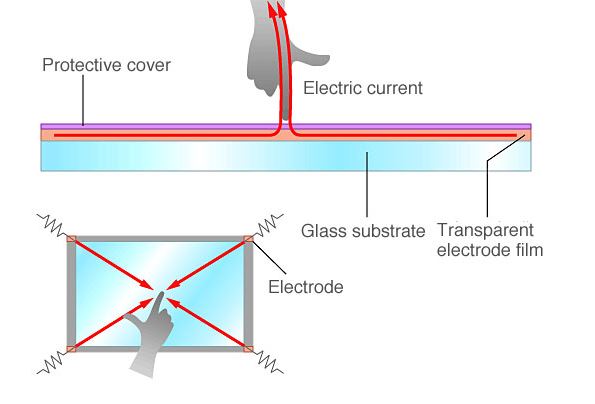
Unlike a resistive screen, a capacitive screen uses the transfer of an electrical charge from the screen to your finger in order to register a touch point. This design allows for a more interactive experience with more touch points and range of motion.
Although capacitive screens had the same versatility of their resistive ancestors, the new technology allowed for better image resolution and a more interactive experience for the user.
And the future …
So, what does all this mean for the touch screen kiosk of tomorrow? Well, rather than leaving that to my own creative imagination, we reached out to the folks over at Ultrahaptics North America Inc., a company that’s making huge strides in the field of haptic technology in order to use ultrasound to create rich, three-dimensional shapes and textures that can be felt and interacted with my touch, but not seen. Hoping to leverage their futuristic insight, I sat down with Ultrahaptics Marketing Director Heather Macdonald Tait to ask her about her company’s haptic technology and how she envisions it playing a role in the touch screen kiosk of the future.
TM: What inspired the development of your haptic holograms technology?
HMT: The technology was originally inspired by the availability of mid-air gesture recognition products on the consumer market, such as the Xbox Kinect back in the noughties Suddenly, gesture recognition went from tens of thousands of dollars to a couple of hundred. But there was a catch. When players went to use menus, the interfaces were tricky to interact with as there was no haptic feedback. The user simply couldn’t tell, intuitively, if they had reached the right button. This is because humans are actually not all that good at perceiving depth with our eyes alone.
TM: That sounds like quite the cutting-edge stuff. How do you see this haptic hologram technology changing the touchscreen market?
HMT: The real world is 3D, so why would we want our digital worlds to be any different? Taking content and confining it to a 2D rectangular piece of glass limits how we can interact with it, share it, manipulate it. With advanced visual effects such as holograms, either projected through specialist glass or presented through AR glasses, 2D content becomes rich 3D content with depth. The very first thing most users want to do when they see a hologram is to reach out and touch it. Mid-air haptics technology enables them to feel what they are touching and to interact with it in a truly intuitive, instinctive way.
TM: Wow! I’ve got to say, that sounds like the sort of futuristic tech you find in sci-fi movies. What are some real-world applications that you anticipate haptic holograms being used for?
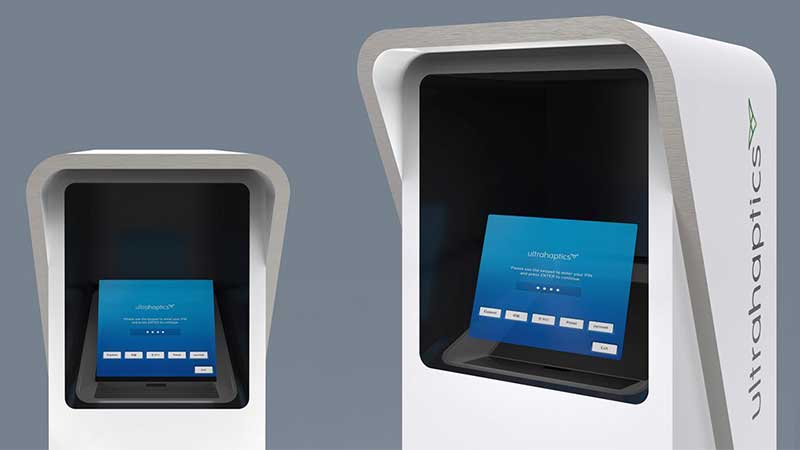
At CES 2018, Ultrahaptics brought touch technology full circle with a futuristic ATM design that incorporates their cutting-edge tech to create a mid-air haptic holographic display.
HMT: There are two main ways in which haptics adds to experiences when combined with holograms. Firstly, for immersion. We are used to reaching out to feel 3D objects. Virtual 3D objects are no different. We want to understand their properties and feel them in our hands. We want experiences that are memorable and entertaining. Haptics is core to these interactions. Secondly, haptics adds a sense of control. The sense of touch is processed by our brain faster than the sense of sight or the sense of hearing. We reach out and touch things almost subconsciously and we need that haptic feedback to make that communication 2 way, to let us know that our gestures or controls are being recognized by our devices.
TM: I couldn’t agree more! Amplifying the way people experience information with a touchscreen kiosk. Now here’s the big question: Do you envision a world where haptic hologram technology is the new standard for touch screen kiosk interfaces? What does that world look like?
HMT: The real world is 3D so it makes sense that our digital lives will become more 3D too. A world where haptic holograms replace touchscreens is a safer, cleaner, more accessible world. When we move away from having to physically touch devices to interact with them, we can operate them with all the efficiencies of the gestures we currently swipe and tap onto glass rectangles but without the transmission of pathogens, without the need to take our eyes off our tasks to, for example, change the music we’re listening to, and without the physical restraints of having to reach to interact in a fixed plane.
Thanks for taking the time to check out our blog. For questions about any of our self-service hardware and software solutions, you can connect with one of our Project Consultants by dialing 1 (603) 865 – 1000.

